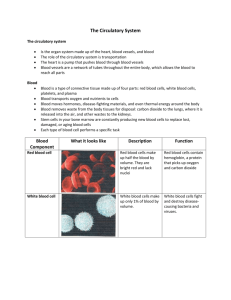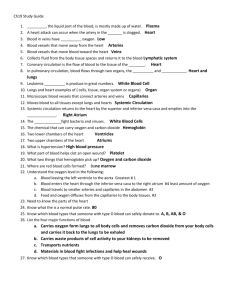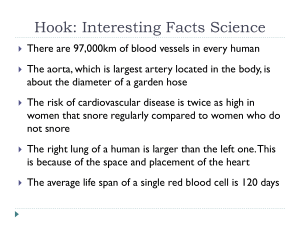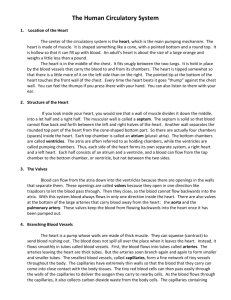Answers to Mastering Concepts Questions
advertisement
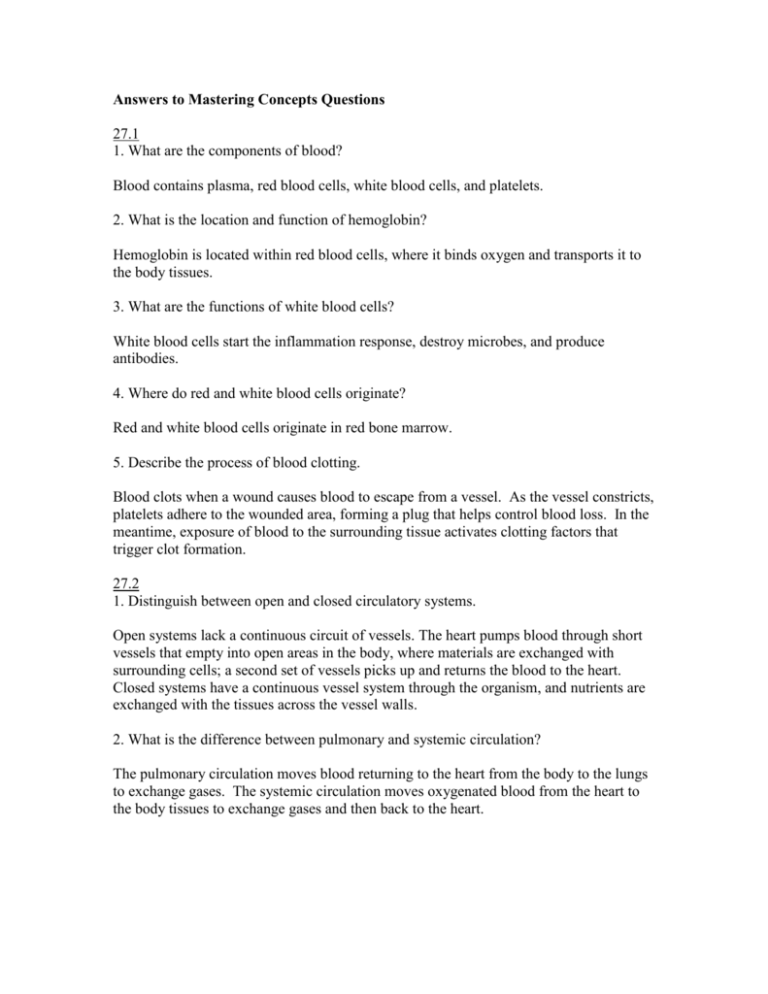
Answers to Mastering Concepts Questions 27.1 1. What are the components of blood? Blood contains plasma, red blood cells, white blood cells, and platelets. 2. What is the location and function of hemoglobin? Hemoglobin is located within red blood cells, where it binds oxygen and transports it to the body tissues. 3. What are the functions of white blood cells? White blood cells start the inflammation response, destroy microbes, and produce antibodies. 4. Where do red and white blood cells originate? Red and white blood cells originate in red bone marrow. 5. Describe the process of blood clotting. Blood clots when a wound causes blood to escape from a vessel. As the vessel constricts, platelets adhere to the wounded area, forming a plug that helps control blood loss. In the meantime, exposure of blood to the surrounding tissue activates clotting factors that trigger clot formation. 27.2 1. Distinguish between open and closed circulatory systems. Open systems lack a continuous circuit of vessels. The heart pumps blood through short vessels that empty into open areas in the body, where materials are exchanged with surrounding cells; a second set of vessels picks up and returns the blood to the heart. Closed systems have a continuous vessel system through the organism, and nutrients are exchanged with the tissues across the vessel walls. 2. What is the difference between pulmonary and systemic circulation? The pulmonary circulation moves blood returning to the heart from the body to the lungs to exchange gases. The systemic circulation moves oxygenated blood from the heart to the body tissues to exchange gases and then back to the heart. 27.3 1. What is the cardiovascular system? The cardiovascular system is the combination of heart, blood, and blood vessels. 2. Describe the relationships among arteries, veins, arterioles, venules, and capillaries. Arteries are the major vessels that carry blood away from the heart; they branch into smaller arterioles, which become the network of capillaries where materials are exchanged between the blood and tissues. The capillaries rejoin to form the venules, which become the larger veins for returning blood to the heart. 27.4 1. Describe the anatomy of the heart. The heart has four chambers: two atria on the top and two ventricles on the bottom. The atria receive blood, and the ventricles pump blood out of the heart. Two valves separate the atria from the ventricles, and two valves separate the ventricles from the blood vessels leaving the heart. 2. Describe the path of blood through the heart’s chambers and valves, and through the pulmonary and systemic circulations. Blood flows along this pathway: right atrium, right ventricle, to the lungs via the pulmonary artery, to the capillaries of the lungs (pulmonary circulation), and then back to the heart via the pulmonary veins. The pulmonary vein empties into the left atrium, from which blood passes through the left ventricle, and then to the body tissues (systemic circulation) via the aorta. Blood from the systemic circulation returns to the right atrium, and the cycle continues. A valve separates each atrium from its neighboring ventricle and separates each ventricle from the blood vessels leaving the heart. 3. What is the function of heart valves? Heart valves prevent the backflow of blood. 4. How does heartbeat originate and spread? The heartbeat originates in the sinoatrial node (pacemaker). It spreads across the atria to the AV node that sends an electrical signal to the ventricle walls. 5. How does exercise affect the circulatory system? Exercise affects the circulatory system in several ways. It strengthens the heart, increases its cardiac output, allows it to pump out a greater volume of blood each minute, and allows it to increase the rate at which it beats. Exercise can also cause extra blood vessels to develop within the walls of the heart. 27.5 1. Compare and contrast the structures of arteries, capillaries, and veins. Arteries, veins, and capillaries are similar in that all are blood vessels and all have an inner layer of endothelial cells. Capillaries are the smallest vessels, consisting of only a single layer of endothelial cells. Arteries and veins are much larger. Arteries take blood away from the heart, whereas veins bring blood to the heart. The force of heart contractions moves blood in arteries, which have a thicker wall of smooth muscle than do veins. Skeletal muscle contraction helps return blood to the heart. Large and mediumsized veins of the legs have venous valves that prevent backflow of blood. 2. Trace the path of a red blood cell from the heart to a capillary bed in the foot and back to the heart. Left ventricle of heart – aorta – femoral artery – artery to foot – arteriole – capillary bed in the foot – venule – vein from foot – femoral vein – inferior vena cava – right atrium of heart 3. Across the human circulatory system, how are blood pressure, blood velocity, and vessel diameter related? Blood pressure and velocity are greatest in the largest arteries, and blood pressure is lowest in the veins. Vessel diameter is smallest in the capillaries, but capillaries have the greatest cross-sectional area, so blood velocity is lowest in the capillaries. 4. How does regulation of blood pressure illustrate negative feedback? When blood pressure is too high, the autonomic nervous system will dilate arterioles in the skin and decrease the heart rate. These have the net effect of decreasing blood pressure, bringing it back to normal. In contrast, if blood pressure is too low, the arterioles in the skin will constrict and the heart rate will increase, with the net effect of increasing blood pressure. In addition, the body raises or lowers blood volume through control of the amount of fluid lost through the kidneys. 27.6 1. What is the main function of the respiratory system? The main function of the respiratory system is to exchange gases with the atmosphere. 2. What is the relationship between the circulatory and respiratory systems? The respiratory system exchanges gases with the atmosphere, removing CO2 from the bloodstream and acquiring O2. The circulatory system delivers O2 to cells and picks up CO2. So, these two systems are partners in gas exchange. 3. List the components of the upper and lower respiratory tracts. Upper: Nose, pharynx, and larynx. Lower: Trachea and lungs. 4. Describe the relationships among the trachea, bronchi, bronchioles, and alveoli. The trachea is the windpipe, or passageway to the lungs. The trachea branches into two bronchi, one leading to each lung. Inside each lung, the bronchi are further divided into bronchioles. The bronchioles lead to alveolar ducts, which open to the alveoli. 27.7 1. What is the relationship between the volume of the chest cavity and the air pressure in the lungs? As the volume of the chest cavity decreases, air pressure in lungs increases; as the volume of the chest cavity increases, air pressure in lungs decreases. 2. Describe the events of one respiratory cycle. In inhalation, the diaphragm and skeletal muscles of the chest contract; the rib cage moves up, and the diaphragm moves down. The volume of the chest cavity increases, air pressure in the lungs decreases, and air rushes into the lungs. In exhalation, the diaphragm and skeletal muscles of the chest relax; the rib cage moves down, and the diaphragm moves up. The volume of the chest cavity decreases, air pressure in the lungs increases, and air is forced out of the lungs. 3. Define tidal volume and vital capacity. Tidal volume is the air exchanged with each relaxed breath, and vital capacity is the maximum volume of air a person can exhale after taking the deepest possible breath. 27.8 1. Describe the direction of O2 and CO2 diffusion in external and internal respiration. In external respiration at the lungs, CO2 diffuses out of the red blood cells and plasma, and into the alveoli. O2 moves in the opposite direction. In internal respiration (at the rest of the body), O2 diffuses out of the blood and into the tissues, while CO2 moves into the bloodstream. 2. In what forms does blood transport O2 and CO2? Most O2 is bound to hemoglobin, although about 1% travels as dissolved gas in the plasma. Most CO2 is carried as bicarbonate ions. 3. How does the brain regulate breathing rate? Multiple chemoreceptors send information about blood pH and CO2 concentrations to the brain. Neurons in the medulla integrate this information and regulate the contraction of rib and diaphragm muscles. 27.9 1. How did researchers use DNA evidence to determine why icefishes have colorless blood? They collected DNA from icefishes and from their close relatives that have red blood. When they sequenced the globin genes from all of the fishes, they discovered that the globin genes in icefishes are unable to encode normal hemoglobin proteins. 2. Which component of blood is likely to transport most of the oxygen in an icefish? Most of the oxygen is probably dissolved in the blood plasma. Answers to Write It Out Questions 1. Maintaining the proper proportions of cells and platelets in the blood is essential for health. What can happen when the blood contains too few or too many red blood cells? Too few or too many white blood cells? Too few or too many platelets? When blood contains too few red blood cells, the body’s ability to deliver O2 to cells is hampered. When there are too many red blood cells, blood becomes too thick and blood pressure increases. When blood contains too few white blood cells, the immune system suffers. When there are too many white cells, then red blood cell formation may be hindered, causing anemia. If platelet counts are low, an individual may not be able to stop bleeding when injured. If platelets are too abundant, a blood clot could form inside a vessel and cut off circulation. 2. Why can a person with type A blood not receive a transfusion of type B blood? If a person has type O blood, what blood type(s) can he or she receive in a transfusion? Each blood type has a unique set of markers. If a person with type A blood is given type B blood, her immune system will recognize the foreign markers and cause the blood to clump together (agglutinate). A person with type O blood can only receive type O blood. 3. Why is blood clotting that happens too quickly or too slowly dangerous? Blood that clots too easily or quickly can lead to dangerous clots that plug blood vessels and may cause death. Blood that clots too slowly can cause an injured person to bleed to death. 4. One effect of aspirin is to prevent platelets from sticking together. Why do some people take low doses of aspirin to help prevent a heart attack? When the platelets don’t easily stick together, the blood doesn’t clot as easily, reducing the chance that a blood clot will block a vessel leading to the heart. 5. How are open and closed circulatory systems similar? How are they different? Both types of circulatory systems move blood (or a similar fluid) within an animal’s body. In an open circulatory system, the blood directly bathes the body’s cells, whereas in a closed circulatory system, the blood remains confined to vessels and does not come into direct contact with the cells that it is nourishing. 6. Describe the circulatory systems of fishes and mammals. What is the advantage of separating the pulmonary and systemic circulatory pathways? Fish have one circulatory pathway with a two-chambered heart. Mammals have a fourchambered heart that separates the pulmonary and systemic pathways. Separating these pathways is efficient because it ensures that the systemic circulation receives fully oxygenated blood. 7. Describe the events that occur during one cardiac cycle. The heart contracts and relaxes in one cycle. The contraction starts in the atria at the sinoatrial node (pacemaker). The electrical signals converge and delay at the AV node, giving the ventricles time to fill with blood. Lastly, the electrical signal spreads through the ventricles and they contract, pushing blood out of the heart. 8. Make a chart that compares systemic arteries, capillaries, and systemic veins. Consider the following properties: structure; amount of smooth muscle; presence of valves; cross-sectional area; blood pressure; blood velocity; direction of blood flow relative to the heart; O2 content of blood. Characteristic Overall structure Smooth muscle Valves Cross-sectional area Blood pressure Blood velocity Direction of flow Arteries Thick, muscular walls Thick Absent Low Highest Fastest Away from heart O2 content High Capillaries Wall consists of a single layer of cells Absent Absent High Low Slowest Links arteries with veins Low Veins Thin walls Thin Present Low Lowest Slow Towards heart Lowest 9. How do the body’s cells receive nutrients and O2 and dispose of wastes? The cells receive nutrients and oxygen from the fluid around the cells at the capillary beds. The oxygen and nutrients move into the cells by diffusion or active transport. Wastes are eliminated from the cell through diffusion or active transport, and end up in the fluid surrounding the capillary beds where it moves into the blood to be transported away. 10. Why is blood pressure highest in the arteries and lowest in the veins? Pressure on the arteries is high due to their close proximity to the heart, which pumps blood directly to the arteries. The farther an artery is from the heart, the lower the pressure. Once the blood reaches the veins, there is little or no help from the heart in moving the blood. Instead, skeletal muscle contraction propels blood back to the heart; therefore, the pressure in veins is low. 11. What types of changes in blood vessels would raise blood pressure? Anything that causes the diameter of blood vessels to decrease – from drugs to the buildup of fats in arteries – would raise blood pressure. 12. Some of the body’s blood pressure receptors are located in the carotid sinus, where the carotid artery passes through the neck. If you press lightly on the carotid sinus, what do you predict should happen to your heart rate? What if you press lightly on a spot just below the carotid sinus? Hint: Figure 27.13 may help you answer this question. Pressure on the carotid sinus would cause the receptors to sense an increase in pressure. This will cause the heart rate to drop to counter the perceived rise in pressure. This drop in pressure could actually cause a person to pass out. If you press just below the sinus then less blood will enter the sinus and a drop in pressure will be detected. This will result in an increase in heart rate to compensate. 13. Describe the interactions between the circulatory system and the respiratory, immune, digestive, and endocrine systems. Blood passing through the respiratory system disposes of waste CO2 and picks up O2 to deliver to the tissues. White blood cells are immune system cells that are carried throughout the body in blood. Blood passing near the digestive system picks up nutrients and carries them to the body’s cells. The endocrine system secretes hormones that are carried in the bloodstream. 14. Name three ways that the circulatory system helps maintain homeostasis. The circulatory system delivers O2 for cells to use in aerobic respiration, which restores depleted ATP. Second, the circulatory system removes wastes from the cells, preventing the buildup of harmful products. Third, hormones circulate in the bloodstream; hormones maintain homeostasis in many ways. 15. Section 8.7 describes the rationale behind cancer treatments that inhibit the growth of blood vessels toward a tumor. Why would tumors without a blood supply quit growing (or even shrink)? Without a blood supply there would be no oxygen or nutrients delivered to the tumor cells, and so they could not grow or carry out cellular respiration. 16. What is the function of breathing? Breathing supplies O2 to the cells for aerobic respiration and removes waste CO2. 17. What is the connection between breathing and cellular respiration? An organism must inhale to acquire O2 for its cells. The cells need O2 to undergo cellular respiration. A product of cellular respiration is CO2, which animals dispose of as they exhale. 18. An earthworm prefers moist soil. Why does this animal die if it dries out on a sidewalk? The earthworm needs to keep its epidermis moist to facilitate gas exchange across its body surface. 19. How is air cleaned, warmed, and humidified before it reaches the lungs? Large particles are cleaned from inhaled air by hairs in the nose or sneezing reflexes, while smaller particles and bacteria are trapped in mucus and destroyed by the enzymes. Air is also humidified by the mucus and warmed by the rich blood supply in the nose. 20. Trace the path of an O2 molecule from the time it enters the nose to the time it reaches a respiring cell at the tip of your finger. Oxygen in air travels through the nose, through the larynx, and into the trachea. It then travels through a bronchus, bronchiole, and alveolar duct into an individual alveolus. The oxygen molecule then diffuses across the alveolar wall and into a red blood cell inside a capillary. The red blood cell will travel through the left side of the heart, through the aorta, and out to the cells of the finger tip. The oxygen will diffuse across the capillary bed to the respiring cell. 21. Describe the events that happen during inhalation and exhalation. During inhalation, the skeletal muscles of the diaphragm and rib cage contract, expanding the lungs. This drops the air pressure in the lungs, drawing in the air. When the muscles relax to their original positions, the lungs contract back in size, raising pressure, and air exits the lungs. 22. What is the difference between tidal volume and vital capacity? What does each measurement indicate about lung function? Tidal volume is the air contained in a relaxed breath. It represents the efficiency of the lungs at rest. Vital capacity is a much larger volume of air drawn from a maximum inhalation-exhalation cycle. It represents the maximum amount of air a person can access with one breath. 23. Explain the diffusion gradients for O2 and CO2 at alveoli and at body cells. CO2 diffuses out of the red blood cells and plasma and into the alveoli of the lungs. O2 moves in the opposite direction. In the rest of the body, O2 diffuses out of the blood and into the tissues, while CO2 moves into the bloodstream. 24. How does blood transport most of the CO2 produced by the body’s cells? In what other ways is CO2 transported? About 5-10% of CO2 travels as dissolved gas in the plasma, and 23% travels on hemoglobin. The remaining 70% of CO2 travels in the plasma as bicarbonate ions. 25. One recommended treatment for anxiety-related hyperventilation (overbreathing) is to breathe into a paper bag for several minutes. After several breaths, how does the composition of air inside the bag compare with that in the atmosphere? How would breathing air from the bag help relieve hyperventilation? How might it be dangerous to breathe into a paper bag for more than a few minutes? Exhaling into a paper bag causes the CO2 concentration in the bag to increase relative to the concentration in the atmosphere. Rebreathing the contents of the bag raises the blood’s CO2 content and restores the normal breathing rate. If this is done for too long, however, the CO2 in the body would rise too high and the O2 would decline, which could be lethal. Answers to Pull It Together Questions 1. How do the pulmonary and systemic circulatory pathways fit into this concept map? “Heart” connects with the phrase “delivers blood to lungs via the” to “Pulmonary circulation”. “Heart” connects with the phrase “delivers blood to the rest of the body via the” to “Systemic circulation”. 2. What other substances are in blood besides those listed in this concept map? Besides what is listed in the concept map, nutrients (like glucose), waste products (like urea), dissolved gases (like carbon dioxide), and hormones (like insulin) are all found in the blood. 3. What are the functions of red and white blood cells? Red blood cells have one main function: to deliver O2 to the body’s tissues and remove CO2 from them. White blood cells are very different; they are part of the immune system. They patrol the body for invasive materials and pathogens. 4. Add the following terms to this concept map: diaphragm, alveolus, interstitial fluid, brain, hemoglobin, O2, CO2. “Diaphragm” connects to the phrase “contracts to allow air to move into the” to “Lungs”. “Alveolus” connects with the phrase “is an air sac within the” to “Lungs”. Alveolus also connects with the phrase “delivers” to “O2” and connects with the phrase “removes” to “CO2”. “Interstitial fluid” connects with the phrase “is derived from “Plasma”. “Brain” connects with the phrase “regulates contraction of” to “Heart” and to “Diaphragm”. “Hemoglobin” connects with the phrase “carries O2 in” to “Red blood cells”. 5. Describe the relationships among the parts of the upper and lower respiratory tracts. Air moves from the nose to the pharynx and larynx, which together make up the upper respiratory tract. From the larynx, air moves to the trachea, which branches into two bronchi. One bronchus leads to each lung.



